Report on Physiological Principles for Health and Social Care Module
VerifiedAdded on 2020/12/18
|21
|6945
|479
Report
AI Summary
This report delves into the physiological principles crucial for health and social care, examining the skeletal, muscular, and cardiovascular systems, their gross anatomy, and interconnected functions. It explores the body's response to physical activities, the roles of voluntary muscles and gaseous exchange in aerobic activity, and the maintenance of homeostasis. The report also addresses ethical considerations in routine measurements like temperature, pulse, blood pressure, and ECG, along with how these measurements inform care planning. The assignment further analyzes the impact of age and medical conditions on body structure and function, evaluating effective routine care for an individual, Mary, presented in a case study. Overall, the report provides a comprehensive understanding of the physiological principles underpinning health and social care practices.
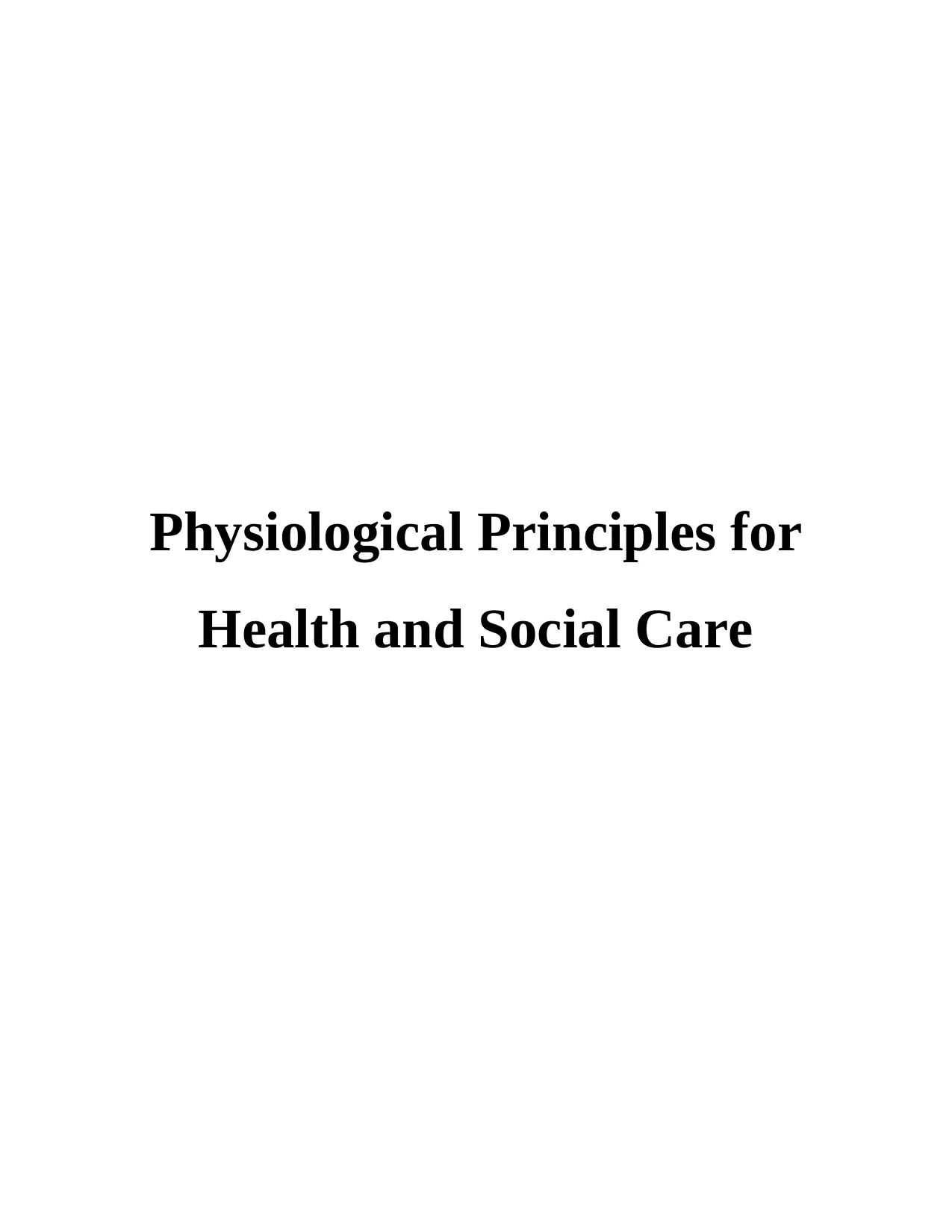
Physiological Principles for
Health and Social Care
Health and Social Care
Paraphrase This Document
Need a fresh take? Get an instant paraphrase of this document with our AI Paraphraser
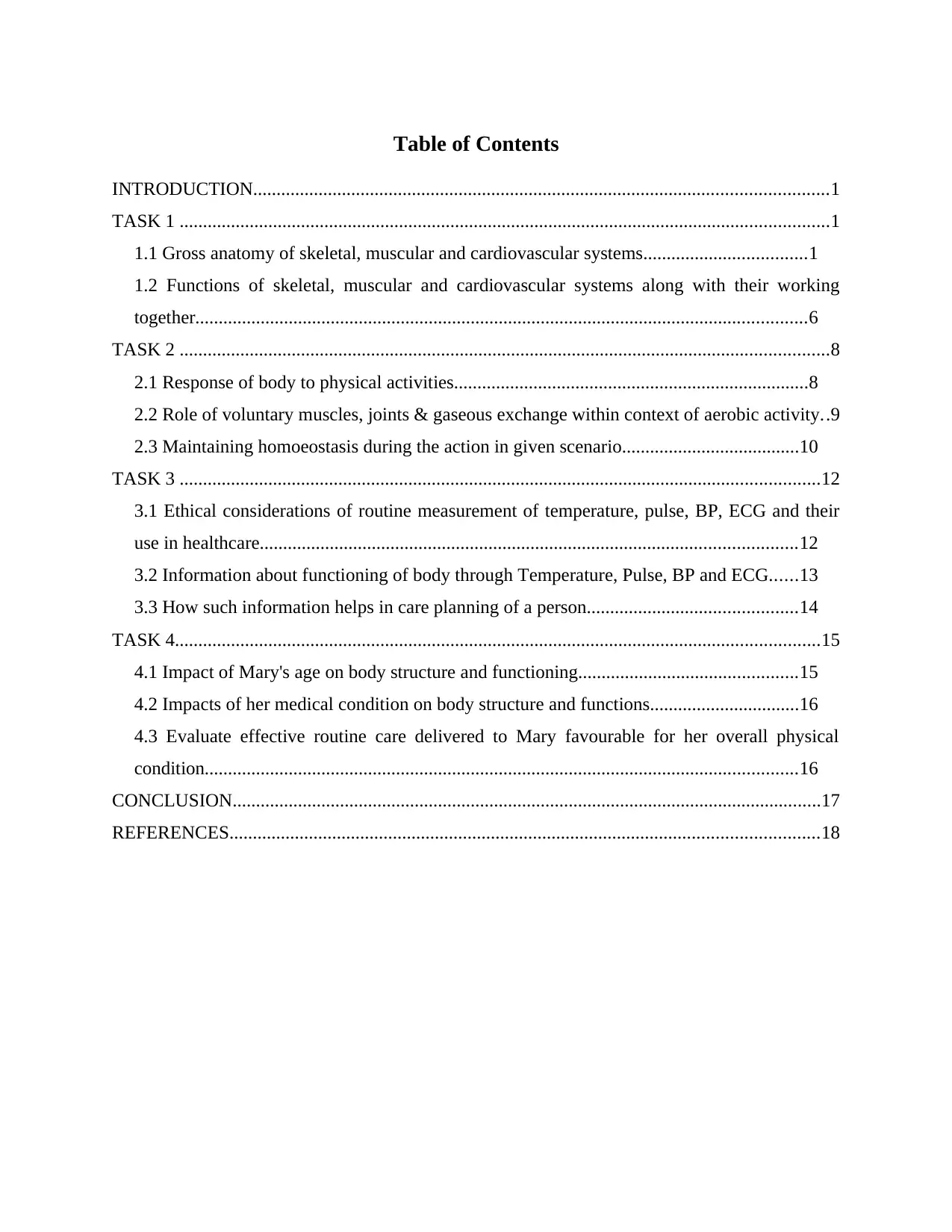
Table of Contents
INTRODUCTION...........................................................................................................................1
TASK 1 ...........................................................................................................................................1
1.1 Gross anatomy of skeletal, muscular and cardiovascular systems...................................1
1.2 Functions of skeletal, muscular and cardiovascular systems along with their working
together...................................................................................................................................6
TASK 2 ...........................................................................................................................................8
2.1 Response of body to physical activities............................................................................8
2.2 Role of voluntary muscles, joints & gaseous exchange within context of aerobic activity..9
2.3 Maintaining homoeostasis during the action in given scenario......................................10
TASK 3 .........................................................................................................................................12
3.1 Ethical considerations of routine measurement of temperature, pulse, BP, ECG and their
use in healthcare...................................................................................................................12
3.2 Information about functioning of body through Temperature, Pulse, BP and ECG......13
3.3 How such information helps in care planning of a person.............................................14
TASK 4..........................................................................................................................................15
4.1 Impact of Mary's age on body structure and functioning...............................................15
4.2 Impacts of her medical condition on body structure and functions................................16
4.3 Evaluate effective routine care delivered to Mary favourable for her overall physical
condition...............................................................................................................................16
CONCLUSION..............................................................................................................................17
REFERENCES..............................................................................................................................18
INTRODUCTION...........................................................................................................................1
TASK 1 ...........................................................................................................................................1
1.1 Gross anatomy of skeletal, muscular and cardiovascular systems...................................1
1.2 Functions of skeletal, muscular and cardiovascular systems along with their working
together...................................................................................................................................6
TASK 2 ...........................................................................................................................................8
2.1 Response of body to physical activities............................................................................8
2.2 Role of voluntary muscles, joints & gaseous exchange within context of aerobic activity..9
2.3 Maintaining homoeostasis during the action in given scenario......................................10
TASK 3 .........................................................................................................................................12
3.1 Ethical considerations of routine measurement of temperature, pulse, BP, ECG and their
use in healthcare...................................................................................................................12
3.2 Information about functioning of body through Temperature, Pulse, BP and ECG......13
3.3 How such information helps in care planning of a person.............................................14
TASK 4..........................................................................................................................................15
4.1 Impact of Mary's age on body structure and functioning...............................................15
4.2 Impacts of her medical condition on body structure and functions................................16
4.3 Evaluate effective routine care delivered to Mary favourable for her overall physical
condition...............................................................................................................................16
CONCLUSION..............................................................................................................................17
REFERENCES..............................................................................................................................18
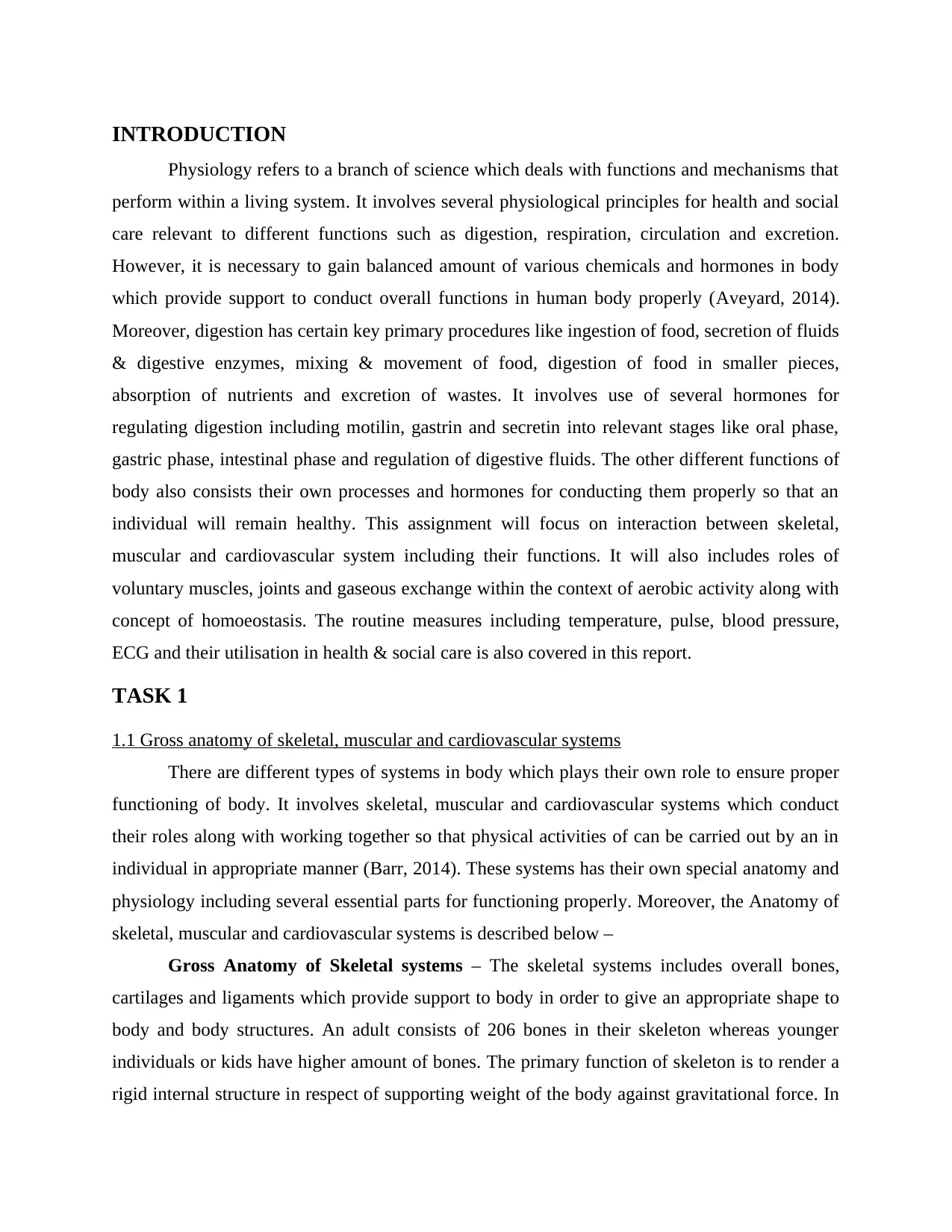
INTRODUCTION
Physiology refers to a branch of science which deals with functions and mechanisms that
perform within a living system. It involves several physiological principles for health and social
care relevant to different functions such as digestion, respiration, circulation and excretion.
However, it is necessary to gain balanced amount of various chemicals and hormones in body
which provide support to conduct overall functions in human body properly (Aveyard, 2014).
Moreover, digestion has certain key primary procedures like ingestion of food, secretion of fluids
& digestive enzymes, mixing & movement of food, digestion of food in smaller pieces,
absorption of nutrients and excretion of wastes. It involves use of several hormones for
regulating digestion including motilin, gastrin and secretin into relevant stages like oral phase,
gastric phase, intestinal phase and regulation of digestive fluids. The other different functions of
body also consists their own processes and hormones for conducting them properly so that an
individual will remain healthy. This assignment will focus on interaction between skeletal,
muscular and cardiovascular system including their functions. It will also includes roles of
voluntary muscles, joints and gaseous exchange within the context of aerobic activity along with
concept of homoeostasis. The routine measures including temperature, pulse, blood pressure,
ECG and their utilisation in health & social care is also covered in this report.
TASK 1
1.1 Gross anatomy of skeletal, muscular and cardiovascular systems
There are different types of systems in body which plays their own role to ensure proper
functioning of body. It involves skeletal, muscular and cardiovascular systems which conduct
their roles along with working together so that physical activities of can be carried out by an in
individual in appropriate manner (Barr, 2014). These systems has their own special anatomy and
physiology including several essential parts for functioning properly. Moreover, the Anatomy of
skeletal, muscular and cardiovascular systems is described below –
Gross Anatomy of Skeletal systems – The skeletal systems includes overall bones,
cartilages and ligaments which provide support to body in order to give an appropriate shape to
body and body structures. An adult consists of 206 bones in their skeleton whereas younger
individuals or kids have higher amount of bones. The primary function of skeleton is to render a
rigid internal structure in respect of supporting weight of the body against gravitational force. In
Physiology refers to a branch of science which deals with functions and mechanisms that
perform within a living system. It involves several physiological principles for health and social
care relevant to different functions such as digestion, respiration, circulation and excretion.
However, it is necessary to gain balanced amount of various chemicals and hormones in body
which provide support to conduct overall functions in human body properly (Aveyard, 2014).
Moreover, digestion has certain key primary procedures like ingestion of food, secretion of fluids
& digestive enzymes, mixing & movement of food, digestion of food in smaller pieces,
absorption of nutrients and excretion of wastes. It involves use of several hormones for
regulating digestion including motilin, gastrin and secretin into relevant stages like oral phase,
gastric phase, intestinal phase and regulation of digestive fluids. The other different functions of
body also consists their own processes and hormones for conducting them properly so that an
individual will remain healthy. This assignment will focus on interaction between skeletal,
muscular and cardiovascular system including their functions. It will also includes roles of
voluntary muscles, joints and gaseous exchange within the context of aerobic activity along with
concept of homoeostasis. The routine measures including temperature, pulse, blood pressure,
ECG and their utilisation in health & social care is also covered in this report.
TASK 1
1.1 Gross anatomy of skeletal, muscular and cardiovascular systems
There are different types of systems in body which plays their own role to ensure proper
functioning of body. It involves skeletal, muscular and cardiovascular systems which conduct
their roles along with working together so that physical activities of can be carried out by an in
individual in appropriate manner (Barr, 2014). These systems has their own special anatomy and
physiology including several essential parts for functioning properly. Moreover, the Anatomy of
skeletal, muscular and cardiovascular systems is described below –
Gross Anatomy of Skeletal systems – The skeletal systems includes overall bones,
cartilages and ligaments which provide support to body in order to give an appropriate shape to
body and body structures. An adult consists of 206 bones in their skeleton whereas younger
individuals or kids have higher amount of bones. The primary function of skeleton is to render a
rigid internal structure in respect of supporting weight of the body against gravitational force. In
⊘ This is a preview!⊘
Do you want full access?
Subscribe today to unlock all pages.

Trusted by 1+ million students worldwide
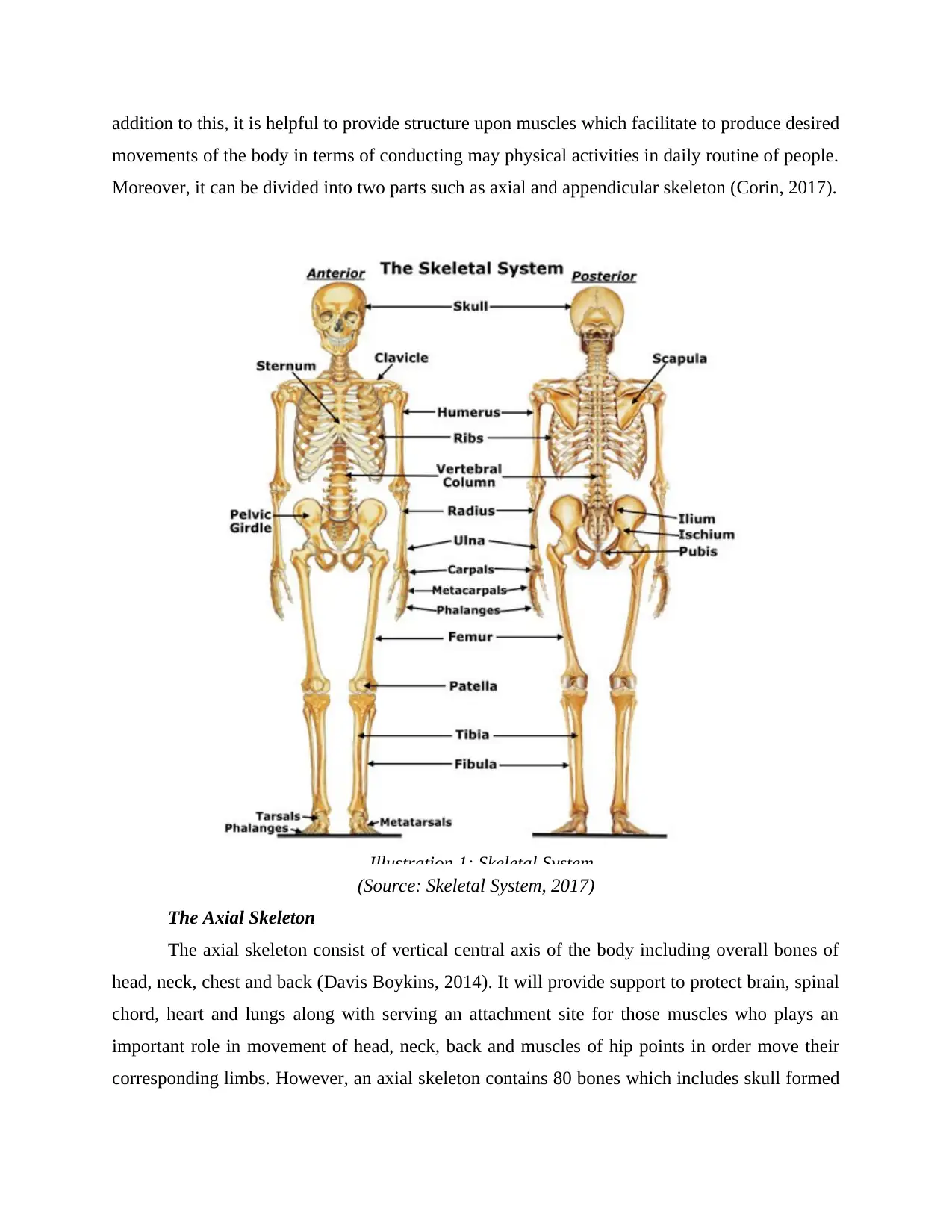
addition to this, it is helpful to provide structure upon muscles which facilitate to produce desired
movements of the body in terms of conducting may physical activities in daily routine of people.
Moreover, it can be divided into two parts such as axial and appendicular skeleton (Corin, 2017).
(Source: Skeletal System, 2017)
The Axial Skeleton
The axial skeleton consist of vertical central axis of the body including overall bones of
head, neck, chest and back (Davis Boykins, 2014). It will provide support to protect brain, spinal
chord, heart and lungs along with serving an attachment site for those muscles who plays an
important role in movement of head, neck, back and muscles of hip points in order move their
corresponding limbs. However, an axial skeleton contains 80 bones which includes skull formed
Illustration 1: Skeletal System
movements of the body in terms of conducting may physical activities in daily routine of people.
Moreover, it can be divided into two parts such as axial and appendicular skeleton (Corin, 2017).
(Source: Skeletal System, 2017)
The Axial Skeleton
The axial skeleton consist of vertical central axis of the body including overall bones of
head, neck, chest and back (Davis Boykins, 2014). It will provide support to protect brain, spinal
chord, heart and lungs along with serving an attachment site for those muscles who plays an
important role in movement of head, neck, back and muscles of hip points in order move their
corresponding limbs. However, an axial skeleton contains 80 bones which includes skull formed
Illustration 1: Skeletal System
Paraphrase This Document
Need a fresh take? Get an instant paraphrase of this document with our AI Paraphraser
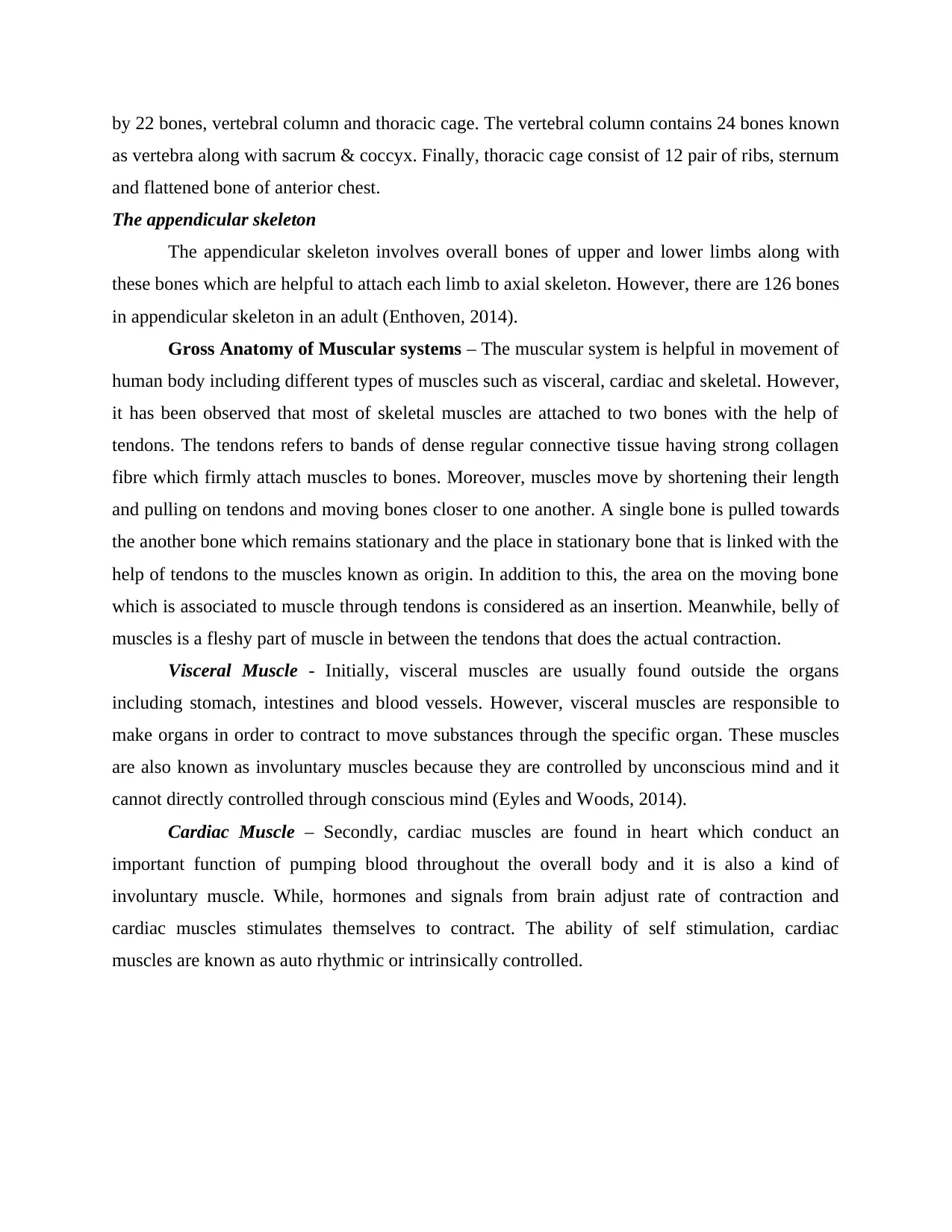
by 22 bones, vertebral column and thoracic cage. The vertebral column contains 24 bones known
as vertebra along with sacrum & coccyx. Finally, thoracic cage consist of 12 pair of ribs, sternum
and flattened bone of anterior chest.
The appendicular skeleton
The appendicular skeleton involves overall bones of upper and lower limbs along with
these bones which are helpful to attach each limb to axial skeleton. However, there are 126 bones
in appendicular skeleton in an adult (Enthoven, 2014).
Gross Anatomy of Muscular systems – The muscular system is helpful in movement of
human body including different types of muscles such as visceral, cardiac and skeletal. However,
it has been observed that most of skeletal muscles are attached to two bones with the help of
tendons. The tendons refers to bands of dense regular connective tissue having strong collagen
fibre which firmly attach muscles to bones. Moreover, muscles move by shortening their length
and pulling on tendons and moving bones closer to one another. A single bone is pulled towards
the another bone which remains stationary and the place in stationary bone that is linked with the
help of tendons to the muscles known as origin. In addition to this, the area on the moving bone
which is associated to muscle through tendons is considered as an insertion. Meanwhile, belly of
muscles is a fleshy part of muscle in between the tendons that does the actual contraction.
Visceral Muscle - Initially, visceral muscles are usually found outside the organs
including stomach, intestines and blood vessels. However, visceral muscles are responsible to
make organs in order to contract to move substances through the specific organ. These muscles
are also known as involuntary muscles because they are controlled by unconscious mind and it
cannot directly controlled through conscious mind (Eyles and Woods, 2014).
Cardiac Muscle – Secondly, cardiac muscles are found in heart which conduct an
important function of pumping blood throughout the overall body and it is also a kind of
involuntary muscle. While, hormones and signals from brain adjust rate of contraction and
cardiac muscles stimulates themselves to contract. The ability of self stimulation, cardiac
muscles are known as auto rhythmic or intrinsically controlled.
as vertebra along with sacrum & coccyx. Finally, thoracic cage consist of 12 pair of ribs, sternum
and flattened bone of anterior chest.
The appendicular skeleton
The appendicular skeleton involves overall bones of upper and lower limbs along with
these bones which are helpful to attach each limb to axial skeleton. However, there are 126 bones
in appendicular skeleton in an adult (Enthoven, 2014).
Gross Anatomy of Muscular systems – The muscular system is helpful in movement of
human body including different types of muscles such as visceral, cardiac and skeletal. However,
it has been observed that most of skeletal muscles are attached to two bones with the help of
tendons. The tendons refers to bands of dense regular connective tissue having strong collagen
fibre which firmly attach muscles to bones. Moreover, muscles move by shortening their length
and pulling on tendons and moving bones closer to one another. A single bone is pulled towards
the another bone which remains stationary and the place in stationary bone that is linked with the
help of tendons to the muscles known as origin. In addition to this, the area on the moving bone
which is associated to muscle through tendons is considered as an insertion. Meanwhile, belly of
muscles is a fleshy part of muscle in between the tendons that does the actual contraction.
Visceral Muscle - Initially, visceral muscles are usually found outside the organs
including stomach, intestines and blood vessels. However, visceral muscles are responsible to
make organs in order to contract to move substances through the specific organ. These muscles
are also known as involuntary muscles because they are controlled by unconscious mind and it
cannot directly controlled through conscious mind (Eyles and Woods, 2014).
Cardiac Muscle – Secondly, cardiac muscles are found in heart which conduct an
important function of pumping blood throughout the overall body and it is also a kind of
involuntary muscle. While, hormones and signals from brain adjust rate of contraction and
cardiac muscles stimulates themselves to contract. The ability of self stimulation, cardiac
muscles are known as auto rhythmic or intrinsically controlled.

(Source: Muscular System: Facts, Functions & Diseases, 2016)
Skeletal Muscle – Moreover, the skeletal muscles can be considered as one and only
voluntary muscle tissue in human body as they are controlled by conscious mind respectively.
There are various actions which perform by an individual physically including speaking, walking
Illustration 2: Muscular System: Facts, Functions & Diseases
Skeletal Muscle – Moreover, the skeletal muscles can be considered as one and only
voluntary muscle tissue in human body as they are controlled by conscious mind respectively.
There are various actions which perform by an individual physically including speaking, walking
Illustration 2: Muscular System: Facts, Functions & Diseases
⊘ This is a preview!⊘
Do you want full access?
Subscribe today to unlock all pages.

Trusted by 1+ million students worldwide
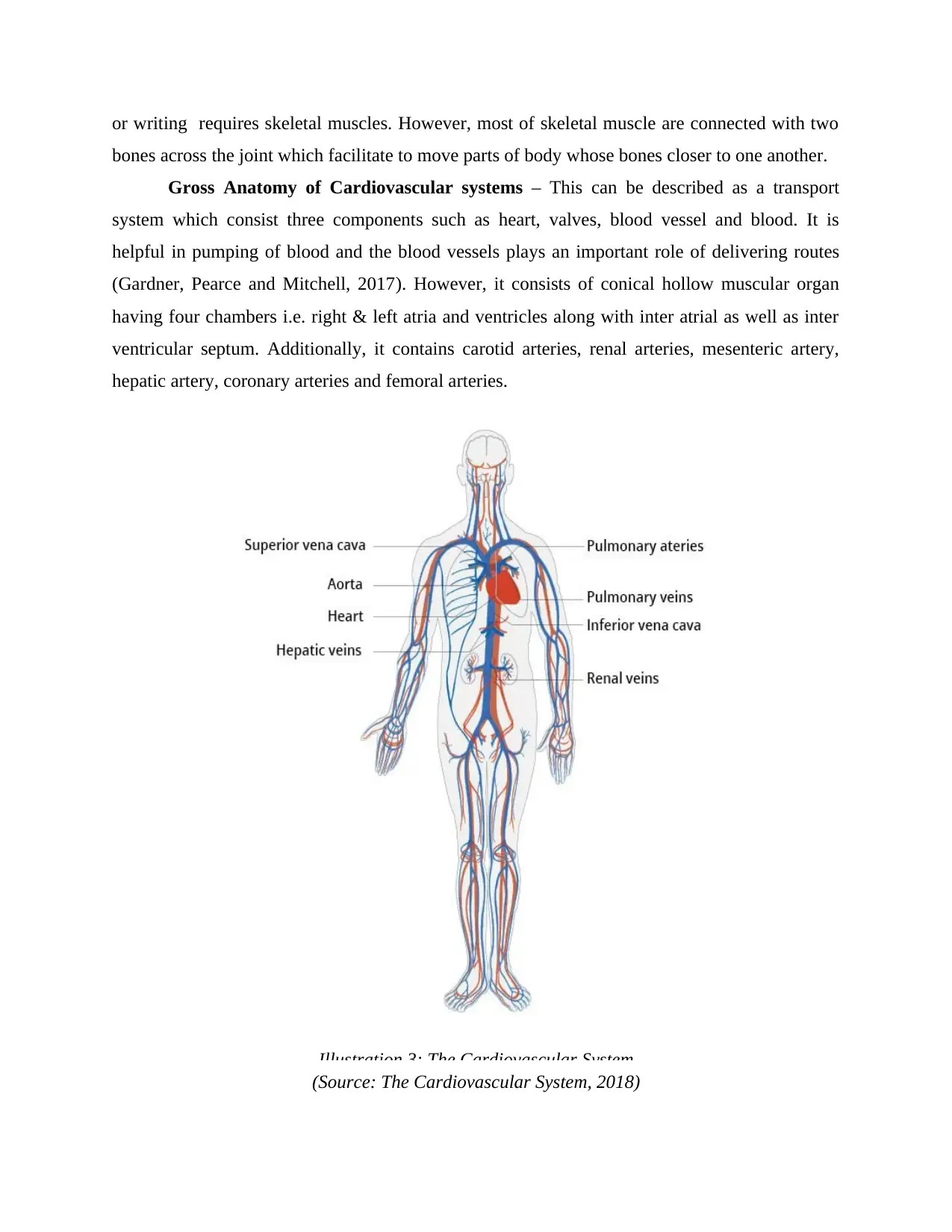
or writing requires skeletal muscles. However, most of skeletal muscle are connected with two
bones across the joint which facilitate to move parts of body whose bones closer to one another.
Gross Anatomy of Cardiovascular systems – This can be described as a transport
system which consist three components such as heart, valves, blood vessel and blood. It is
helpful in pumping of blood and the blood vessels plays an important role of delivering routes
(Gardner, Pearce and Mitchell, 2017). However, it consists of conical hollow muscular organ
having four chambers i.e. right & left atria and ventricles along with inter atrial as well as inter
ventricular septum. Additionally, it contains carotid arteries, renal arteries, mesenteric artery,
hepatic artery, coronary arteries and femoral arteries.
(Source: The Cardiovascular System, 2018)
Illustration 3: The Cardiovascular System
bones across the joint which facilitate to move parts of body whose bones closer to one another.
Gross Anatomy of Cardiovascular systems – This can be described as a transport
system which consist three components such as heart, valves, blood vessel and blood. It is
helpful in pumping of blood and the blood vessels plays an important role of delivering routes
(Gardner, Pearce and Mitchell, 2017). However, it consists of conical hollow muscular organ
having four chambers i.e. right & left atria and ventricles along with inter atrial as well as inter
ventricular septum. Additionally, it contains carotid arteries, renal arteries, mesenteric artery,
hepatic artery, coronary arteries and femoral arteries.
(Source: The Cardiovascular System, 2018)
Illustration 3: The Cardiovascular System
Paraphrase This Document
Need a fresh take? Get an instant paraphrase of this document with our AI Paraphraser

1.2 Functions of skeletal, muscular and cardiovascular systems along with their working together
The functions of skeletal, muscular and cardio vascular system are responsible for normal
functioning of overall body which facilitate to make an individual healthy and comfortable.
However, they play their own functions which together balance the amount of nutrients and other
fluids in order to make human being healthy. The functions of those systems are given below.
Functions of skeletal system
Support, Movement and Protection – The skeletal system basically consist of bones
which provide support to the human body and conduct movement of the sane. It is helpful to
move body parts in order to carrying out various physical activities of body in regular routine of
life (Golightley and Goemans, 2017). However, it is also helpful to protect soft organs of body
and save them from outside damage or injury. Moreover, bones facilitate the movement by
serving as points of attachment to muscles and they protect internal organs like ribs save lung,
vertebral column protect spinal cord as well as skull save brain of human body.
Mineral Storage, Energy Storage and Haematopoiesis – This includes the functions of
bone in respect of working as reservoir for certain essential minerals in body such as calcium and
phosphorus. Bones are also considered as site for fat storage and blood cell production. In
addition to this, it has been analysed that the connective tissues fill interior part of bones is
known as bone marrow. It is of two types i.e. yellow and red bone marrow for their different
functions respectively. Moreover, yellow bone marrow consists of adipose tissues and
triglycerides which is essential for providing source of energy to other tissues of the body.
Furthermore, red bone marrow is responsible for production of blood cells including red blood
cells, white blood cells and platelets (Greene, 2017).
Functions of muscular system
Mobility – This can be considered as main function of muscular system to allow
movement in human body and their contraction facilitate gross & fine movements. Meanwhile,
gross movement refers to large and coordinated movements such as walking, running and
swimming whereas fine movement involves writing, speaking & facial expressions. However,
the muscle movement is controlled by conscious mind and they are reflexive sometimes like
withdrawing hand from source of heat.
The functions of skeletal, muscular and cardio vascular system are responsible for normal
functioning of overall body which facilitate to make an individual healthy and comfortable.
However, they play their own functions which together balance the amount of nutrients and other
fluids in order to make human being healthy. The functions of those systems are given below.
Functions of skeletal system
Support, Movement and Protection – The skeletal system basically consist of bones
which provide support to the human body and conduct movement of the sane. It is helpful to
move body parts in order to carrying out various physical activities of body in regular routine of
life (Golightley and Goemans, 2017). However, it is also helpful to protect soft organs of body
and save them from outside damage or injury. Moreover, bones facilitate the movement by
serving as points of attachment to muscles and they protect internal organs like ribs save lung,
vertebral column protect spinal cord as well as skull save brain of human body.
Mineral Storage, Energy Storage and Haematopoiesis – This includes the functions of
bone in respect of working as reservoir for certain essential minerals in body such as calcium and
phosphorus. Bones are also considered as site for fat storage and blood cell production. In
addition to this, it has been analysed that the connective tissues fill interior part of bones is
known as bone marrow. It is of two types i.e. yellow and red bone marrow for their different
functions respectively. Moreover, yellow bone marrow consists of adipose tissues and
triglycerides which is essential for providing source of energy to other tissues of the body.
Furthermore, red bone marrow is responsible for production of blood cells including red blood
cells, white blood cells and platelets (Greene, 2017).
Functions of muscular system
Mobility – This can be considered as main function of muscular system to allow
movement in human body and their contraction facilitate gross & fine movements. Meanwhile,
gross movement refers to large and coordinated movements such as walking, running and
swimming whereas fine movement involves writing, speaking & facial expressions. However,
the muscle movement is controlled by conscious mind and they are reflexive sometimes like
withdrawing hand from source of heat.
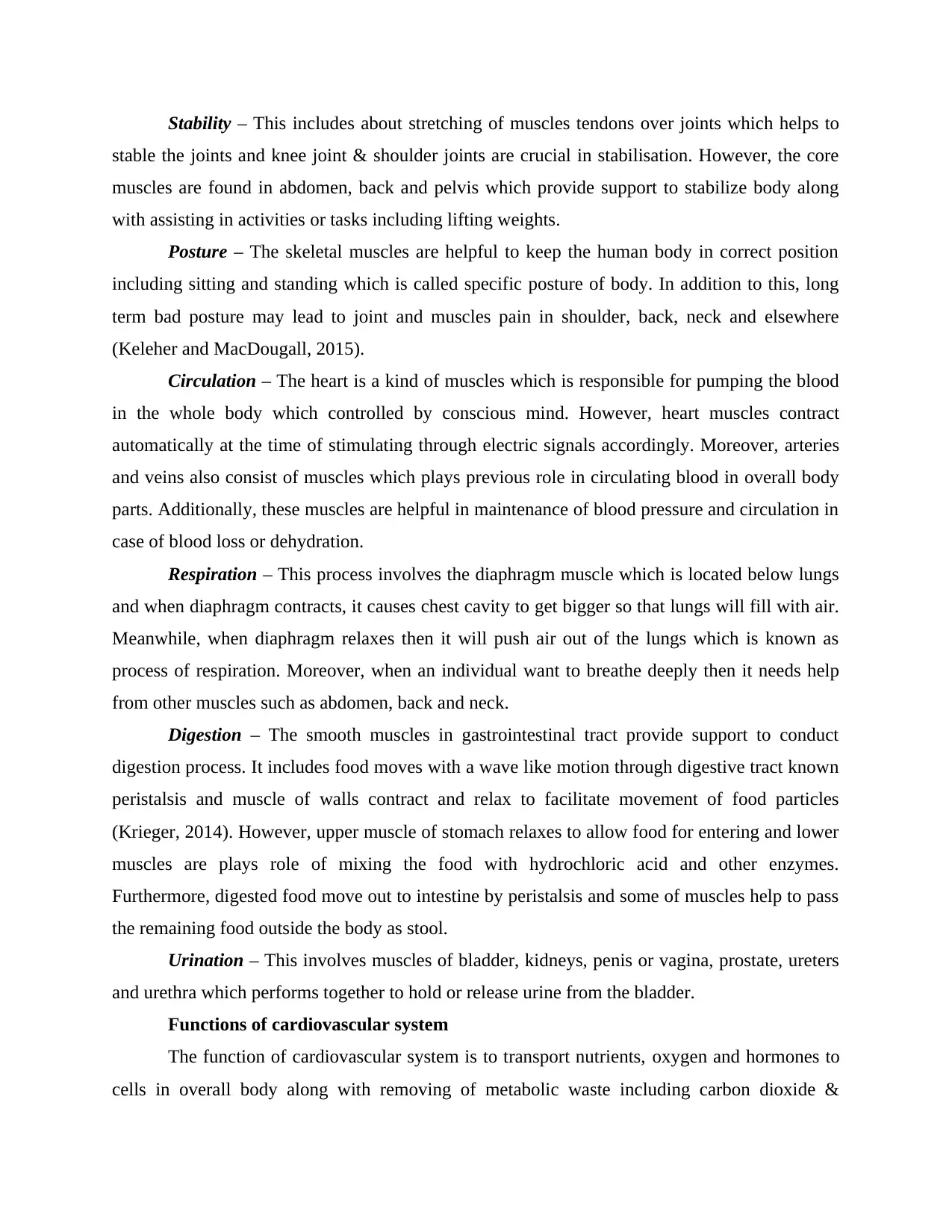
Stability – This includes about stretching of muscles tendons over joints which helps to
stable the joints and knee joint & shoulder joints are crucial in stabilisation. However, the core
muscles are found in abdomen, back and pelvis which provide support to stabilize body along
with assisting in activities or tasks including lifting weights.
Posture – The skeletal muscles are helpful to keep the human body in correct position
including sitting and standing which is called specific posture of body. In addition to this, long
term bad posture may lead to joint and muscles pain in shoulder, back, neck and elsewhere
(Keleher and MacDougall, 2015).
Circulation – The heart is a kind of muscles which is responsible for pumping the blood
in the whole body which controlled by conscious mind. However, heart muscles contract
automatically at the time of stimulating through electric signals accordingly. Moreover, arteries
and veins also consist of muscles which plays previous role in circulating blood in overall body
parts. Additionally, these muscles are helpful in maintenance of blood pressure and circulation in
case of blood loss or dehydration.
Respiration – This process involves the diaphragm muscle which is located below lungs
and when diaphragm contracts, it causes chest cavity to get bigger so that lungs will fill with air.
Meanwhile, when diaphragm relaxes then it will push air out of the lungs which is known as
process of respiration. Moreover, when an individual want to breathe deeply then it needs help
from other muscles such as abdomen, back and neck.
Digestion – The smooth muscles in gastrointestinal tract provide support to conduct
digestion process. It includes food moves with a wave like motion through digestive tract known
peristalsis and muscle of walls contract and relax to facilitate movement of food particles
(Krieger, 2014). However, upper muscle of stomach relaxes to allow food for entering and lower
muscles are plays role of mixing the food with hydrochloric acid and other enzymes.
Furthermore, digested food move out to intestine by peristalsis and some of muscles help to pass
the remaining food outside the body as stool.
Urination – This involves muscles of bladder, kidneys, penis or vagina, prostate, ureters
and urethra which performs together to hold or release urine from the bladder.
Functions of cardiovascular system
The function of cardiovascular system is to transport nutrients, oxygen and hormones to
cells in overall body along with removing of metabolic waste including carbon dioxide &
stable the joints and knee joint & shoulder joints are crucial in stabilisation. However, the core
muscles are found in abdomen, back and pelvis which provide support to stabilize body along
with assisting in activities or tasks including lifting weights.
Posture – The skeletal muscles are helpful to keep the human body in correct position
including sitting and standing which is called specific posture of body. In addition to this, long
term bad posture may lead to joint and muscles pain in shoulder, back, neck and elsewhere
(Keleher and MacDougall, 2015).
Circulation – The heart is a kind of muscles which is responsible for pumping the blood
in the whole body which controlled by conscious mind. However, heart muscles contract
automatically at the time of stimulating through electric signals accordingly. Moreover, arteries
and veins also consist of muscles which plays previous role in circulating blood in overall body
parts. Additionally, these muscles are helpful in maintenance of blood pressure and circulation in
case of blood loss or dehydration.
Respiration – This process involves the diaphragm muscle which is located below lungs
and when diaphragm contracts, it causes chest cavity to get bigger so that lungs will fill with air.
Meanwhile, when diaphragm relaxes then it will push air out of the lungs which is known as
process of respiration. Moreover, when an individual want to breathe deeply then it needs help
from other muscles such as abdomen, back and neck.
Digestion – The smooth muscles in gastrointestinal tract provide support to conduct
digestion process. It includes food moves with a wave like motion through digestive tract known
peristalsis and muscle of walls contract and relax to facilitate movement of food particles
(Krieger, 2014). However, upper muscle of stomach relaxes to allow food for entering and lower
muscles are plays role of mixing the food with hydrochloric acid and other enzymes.
Furthermore, digested food move out to intestine by peristalsis and some of muscles help to pass
the remaining food outside the body as stool.
Urination – This involves muscles of bladder, kidneys, penis or vagina, prostate, ureters
and urethra which performs together to hold or release urine from the bladder.
Functions of cardiovascular system
The function of cardiovascular system is to transport nutrients, oxygen and hormones to
cells in overall body along with removing of metabolic waste including carbon dioxide &
⊘ This is a preview!⊘
Do you want full access?
Subscribe today to unlock all pages.

Trusted by 1+ million students worldwide
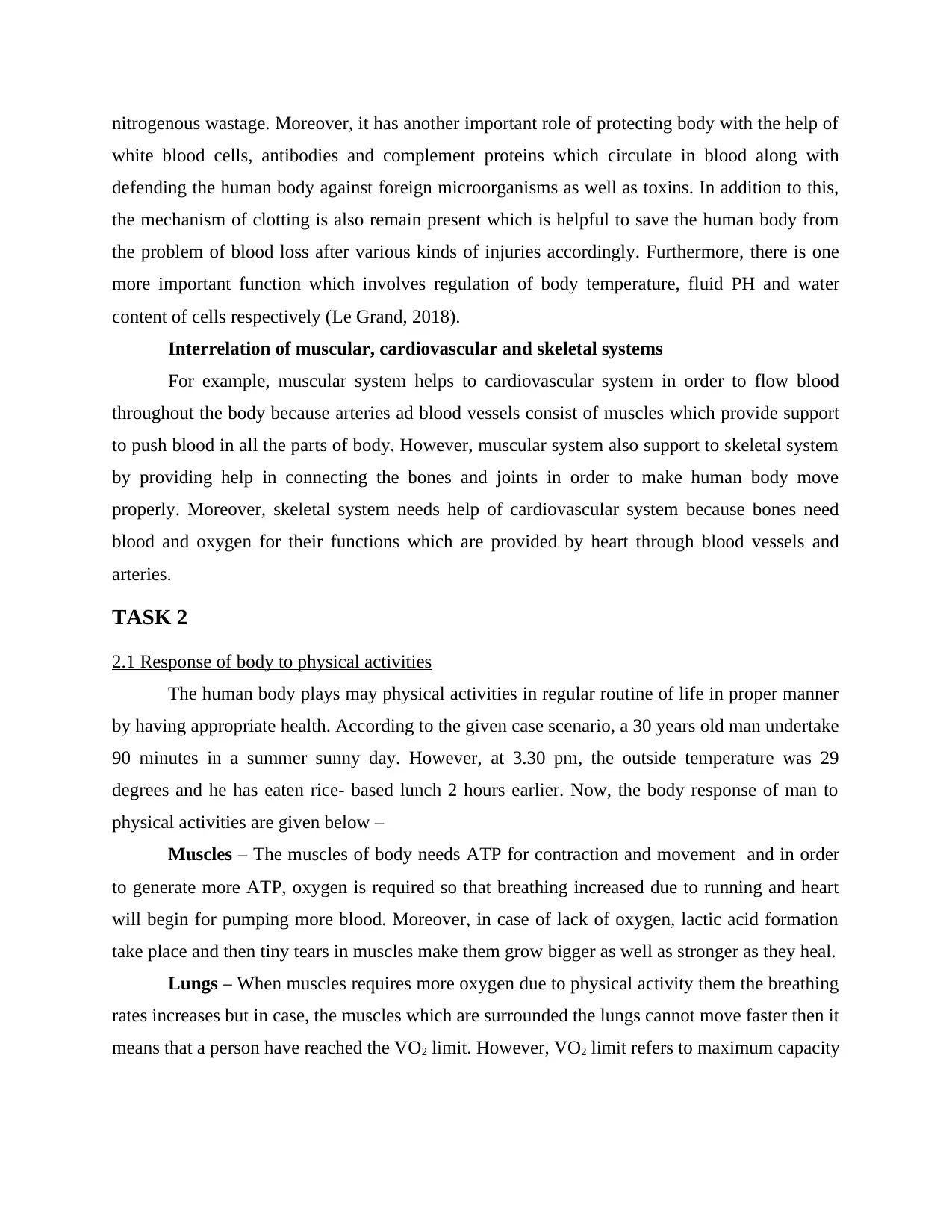
nitrogenous wastage. Moreover, it has another important role of protecting body with the help of
white blood cells, antibodies and complement proteins which circulate in blood along with
defending the human body against foreign microorganisms as well as toxins. In addition to this,
the mechanism of clotting is also remain present which is helpful to save the human body from
the problem of blood loss after various kinds of injuries accordingly. Furthermore, there is one
more important function which involves regulation of body temperature, fluid PH and water
content of cells respectively (Le Grand, 2018).
Interrelation of muscular, cardiovascular and skeletal systems
For example, muscular system helps to cardiovascular system in order to flow blood
throughout the body because arteries ad blood vessels consist of muscles which provide support
to push blood in all the parts of body. However, muscular system also support to skeletal system
by providing help in connecting the bones and joints in order to make human body move
properly. Moreover, skeletal system needs help of cardiovascular system because bones need
blood and oxygen for their functions which are provided by heart through blood vessels and
arteries.
TASK 2
2.1 Response of body to physical activities
The human body plays may physical activities in regular routine of life in proper manner
by having appropriate health. According to the given case scenario, a 30 years old man undertake
90 minutes in a summer sunny day. However, at 3.30 pm, the outside temperature was 29
degrees and he has eaten rice- based lunch 2 hours earlier. Now, the body response of man to
physical activities are given below –
Muscles – The muscles of body needs ATP for contraction and movement and in order
to generate more ATP, oxygen is required so that breathing increased due to running and heart
will begin for pumping more blood. Moreover, in case of lack of oxygen, lactic acid formation
take place and then tiny tears in muscles make them grow bigger as well as stronger as they heal.
Lungs – When muscles requires more oxygen due to physical activity them the breathing
rates increases but in case, the muscles which are surrounded the lungs cannot move faster then it
means that a person have reached the VO2 limit. However, VO2 limit refers to maximum capacity
white blood cells, antibodies and complement proteins which circulate in blood along with
defending the human body against foreign microorganisms as well as toxins. In addition to this,
the mechanism of clotting is also remain present which is helpful to save the human body from
the problem of blood loss after various kinds of injuries accordingly. Furthermore, there is one
more important function which involves regulation of body temperature, fluid PH and water
content of cells respectively (Le Grand, 2018).
Interrelation of muscular, cardiovascular and skeletal systems
For example, muscular system helps to cardiovascular system in order to flow blood
throughout the body because arteries ad blood vessels consist of muscles which provide support
to push blood in all the parts of body. However, muscular system also support to skeletal system
by providing help in connecting the bones and joints in order to make human body move
properly. Moreover, skeletal system needs help of cardiovascular system because bones need
blood and oxygen for their functions which are provided by heart through blood vessels and
arteries.
TASK 2
2.1 Response of body to physical activities
The human body plays may physical activities in regular routine of life in proper manner
by having appropriate health. According to the given case scenario, a 30 years old man undertake
90 minutes in a summer sunny day. However, at 3.30 pm, the outside temperature was 29
degrees and he has eaten rice- based lunch 2 hours earlier. Now, the body response of man to
physical activities are given below –
Muscles – The muscles of body needs ATP for contraction and movement and in order
to generate more ATP, oxygen is required so that breathing increased due to running and heart
will begin for pumping more blood. Moreover, in case of lack of oxygen, lactic acid formation
take place and then tiny tears in muscles make them grow bigger as well as stronger as they heal.
Lungs – When muscles requires more oxygen due to physical activity them the breathing
rates increases but in case, the muscles which are surrounded the lungs cannot move faster then it
means that a person have reached the VO2 limit. However, VO2 limit refers to maximum capacity
Paraphrase This Document
Need a fresh take? Get an instant paraphrase of this document with our AI Paraphraser

to use oxygen which depends upon fitness of an individual. Moreover, higher the fitness of a
person then higher will be the maximum capacity of using of oxygen.
Heart – It is observed that due to running, the heart rates increases in order to supply
more oxygenated blood to muscles of human body (Liaw and et. al., 2014). A heart of fit person
be can effectively do the same response to physical activity and allow it to work out harder &
longer. Moreover, physical activity like running results into increase in blood pressure, heart rate
and breathing rate which is considered as response of body due to improve in demand of
oxygenated muscles.
Brain – The physical activity is responsible for increasing blood flow which facilitate the
brain to perform its function more immediately. It is also helpful to improve focus of an
individual after doing exercise respectively. However, hypothalamus of brain is responsible for
thermoregulation which is applicable when external environment is very hot. Moreover, physical
activity like running in given case rise temperature which cause hypothalamus to send signals to
cells of skin for sweating in terms of regulating body temperature.
Joints and bones – A physical activity or running facilitate to place as much as five or
six times more weight on joints & bones of human body. However, it has been analysed that
peak body mass is achieved in adulthood which can be maintained through regular exercise for
remaining healthy. Additionally, more physical exercise or activities are responsible for reducing
blood glucose level.
2.2 Role of voluntary muscles, joints & gaseous exchange within context of aerobic activity
The aerobic physical activity requires pumping of oxygenated blood through heart in
order to deliver desired amount of oxygen to working muscles accordingly. It is responsible for
stimulating heart rate and breathing rate in terms of increasing in such as manner which can be
appropriate sustained for overall session of any physical activity. However, it is analysed that
aerobic means to involve oxygen to conduct specific physical activity which involves cardio
machines, spinning, running, swimming, walking, hiking, aerobic classes, dancing, cross country
skiing and many more (McGorry and et. al., 2014). Moreover, the voluntary muscles, joints and
gaseous exchange in aerobic activity which are explained further –
Voluntary muscles – This involves skeletal muscles which plays an important to role for
altered an acute and chronic workload induced by aerobic activity. However, these muscles are
responsible for immediate change of contractility to structural adaptations in order to manage the
person then higher will be the maximum capacity of using of oxygen.
Heart – It is observed that due to running, the heart rates increases in order to supply
more oxygenated blood to muscles of human body (Liaw and et. al., 2014). A heart of fit person
be can effectively do the same response to physical activity and allow it to work out harder &
longer. Moreover, physical activity like running results into increase in blood pressure, heart rate
and breathing rate which is considered as response of body due to improve in demand of
oxygenated muscles.
Brain – The physical activity is responsible for increasing blood flow which facilitate the
brain to perform its function more immediately. It is also helpful to improve focus of an
individual after doing exercise respectively. However, hypothalamus of brain is responsible for
thermoregulation which is applicable when external environment is very hot. Moreover, physical
activity like running in given case rise temperature which cause hypothalamus to send signals to
cells of skin for sweating in terms of regulating body temperature.
Joints and bones – A physical activity or running facilitate to place as much as five or
six times more weight on joints & bones of human body. However, it has been analysed that
peak body mass is achieved in adulthood which can be maintained through regular exercise for
remaining healthy. Additionally, more physical exercise or activities are responsible for reducing
blood glucose level.
2.2 Role of voluntary muscles, joints & gaseous exchange within context of aerobic activity
The aerobic physical activity requires pumping of oxygenated blood through heart in
order to deliver desired amount of oxygen to working muscles accordingly. It is responsible for
stimulating heart rate and breathing rate in terms of increasing in such as manner which can be
appropriate sustained for overall session of any physical activity. However, it is analysed that
aerobic means to involve oxygen to conduct specific physical activity which involves cardio
machines, spinning, running, swimming, walking, hiking, aerobic classes, dancing, cross country
skiing and many more (McGorry and et. al., 2014). Moreover, the voluntary muscles, joints and
gaseous exchange in aerobic activity which are explained further –
Voluntary muscles – This involves skeletal muscles which plays an important to role for
altered an acute and chronic workload induced by aerobic activity. However, these muscles are
responsible for immediate change of contractility to structural adaptations in order to manage the

demands of aerobic activities of human body. Moreover, the aerobic physical exercise requires
high volume of low intensity muscular contractions. In addition to this, the muscle fibres, the
cells located within muscles called as mitochondria which provide support in terms of providing
energy through energy forming compound known as adenosine triphosphate i.e. ATP.
Joints – This includes physical activities involving running which encourages circulation
of fluid which facilitate to move joints. Moreover, the joint is surrounded by a soft tissue which
is known as synovial membrane and that provides support to bones in order to move past each
other in more smooth manner (Parahoo, 2014).
Gaseous exchange – The gaseous exchange takes place in the whole body with the help
of respiration process through using alveoli present in lungs. However, it involves the transport
of oxygen to every part of human body in order to conduct physical activity including running
whereas carbon dioxide should be released outside to avoid damage of cells.
2.3 Maintaining homoeostasis during the action in given scenario
Homeostasis refers to feature of system which regulates the internal environment and
tends to maintain stable, relatively constant and condition of properties. Moreover, it is basically
a capability to tendency in respect of maintaining internal stability to compensate for
environmental changes. However, the mechanism of homoeostasis involves three components
such as receptor, control centre and effector. In addition to this, maintenance of homeostasis
during running action of given case study of 30 years old man is given below –
Maintenance of homeostasis
Type of homeostasis Homeostatic process Hormones and other
messengers involved
Tissues, organs and
organ systems
involved
Osmoregulation
(Excretions)
It includes the
procedure of water,
salts and urea expelled
from the human body.
The antidiuretic
hormone (ADH),
aldosterone,
angiotensin II and
carbon dioxide in
terms of maintaining
homeostasis of body.
The osmoregulation
involves urinary
system with kidneys,
urinary bladder &
ureters and endocrine
system including
pituitary gland as well
high volume of low intensity muscular contractions. In addition to this, the muscle fibres, the
cells located within muscles called as mitochondria which provide support in terms of providing
energy through energy forming compound known as adenosine triphosphate i.e. ATP.
Joints – This includes physical activities involving running which encourages circulation
of fluid which facilitate to move joints. Moreover, the joint is surrounded by a soft tissue which
is known as synovial membrane and that provides support to bones in order to move past each
other in more smooth manner (Parahoo, 2014).
Gaseous exchange – The gaseous exchange takes place in the whole body with the help
of respiration process through using alveoli present in lungs. However, it involves the transport
of oxygen to every part of human body in order to conduct physical activity including running
whereas carbon dioxide should be released outside to avoid damage of cells.
2.3 Maintaining homoeostasis during the action in given scenario
Homeostasis refers to feature of system which regulates the internal environment and
tends to maintain stable, relatively constant and condition of properties. Moreover, it is basically
a capability to tendency in respect of maintaining internal stability to compensate for
environmental changes. However, the mechanism of homoeostasis involves three components
such as receptor, control centre and effector. In addition to this, maintenance of homeostasis
during running action of given case study of 30 years old man is given below –
Maintenance of homeostasis
Type of homeostasis Homeostatic process Hormones and other
messengers involved
Tissues, organs and
organ systems
involved
Osmoregulation
(Excretions)
It includes the
procedure of water,
salts and urea expelled
from the human body.
The antidiuretic
hormone (ADH),
aldosterone,
angiotensin II and
carbon dioxide in
terms of maintaining
homeostasis of body.
The osmoregulation
involves urinary
system with kidneys,
urinary bladder &
ureters and endocrine
system including
pituitary gland as well
⊘ This is a preview!⊘
Do you want full access?
Subscribe today to unlock all pages.

Trusted by 1+ million students worldwide
1 out of 21
Related Documents
Your All-in-One AI-Powered Toolkit for Academic Success.
+13062052269
info@desklib.com
Available 24*7 on WhatsApp / Email
![[object Object]](/_next/static/media/star-bottom.7253800d.svg)
Unlock your academic potential
Copyright © 2020–2025 A2Z Services. All Rights Reserved. Developed and managed by ZUCOL.




